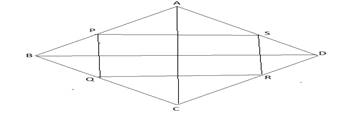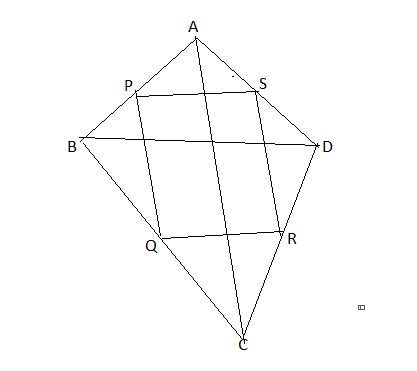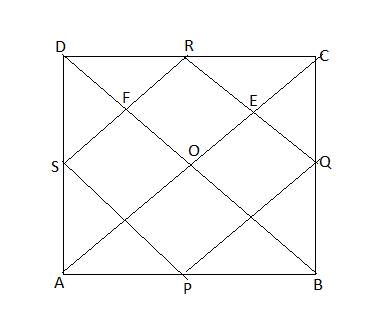
a
To find:The most descriptive name of the figure formed by connecting consecutive midpoints of the sides of the rhombus
a
Answer to Problem 17PSC
The figure formed by joining consecutive midpoints of rhombus will be rectangle
Explanation of Solution
Given information:
A rhombus whose midpoints are joined
Let ABCD be rhombus and P, Q, R and S are the midpoints of sides AB, BC, CD and DA.

In
From (i) and (ii), we have
Further, since diagonals of a rhombus bisect each other at right
Since, SP
b
To find: The most descriptive name of the figure formed by connecting consecutive midpoints of the sides of the kite
b
Answer to Problem 17PSC
The figure formed by joining consecutive midpoints of kite will be rectangle
Explanation of Solution
Given information:
A kite whose midpoints are joined
Let ABCD be kite and P, Q, R and S are the midpoints of sides AB, BC, CD and DA.
Join BD and AC.

Now, In isosceles triangle ABD, P is the midpoint of AB and Q is the midpoint of AD, so we have
Similarly, in triangle BCD,
Hence,
Similarly, we can prove that
Now, using SSS postulate, we can prove that
Therefore, AC is a bisector of isosceles triangle ABD and
Hence
Hence, PQRS is a rectangle
c
To find:The most descriptive name of the figure formed by connecting consecutive midpoints of the sides of the square
c
Answer to Problem 17PSC
The figure formed by joining consecutive midpoints of rhombus will be square
Explanation of Solution
Given information:
A square whose midpoints are joined
Let ABCD be square and P, Q, R and S are the midpoints of sides AB, BC, CD and DA.

In triangle ADC, we have
In triangle ABC, we have
From (i) and (ii), we have
Similarly,
Since diagonals of a square bisect each other at right angle
From (iii) and (iv), we have
PQ = QR = RS = SP
Since diagonals of a square bisect each other at right angles
….. opposite angles are equal
Thus, PQRS is a parallelogram with
d
To find:The most descriptive name of the figure formed by connecting consecutive midpoints of the sides of the rectangle
d
Answer to Problem 17PSC
The figure formed by joining consecutive midpoints of rectangle will be rhombus
Explanation of Solution
Given information:
A rectangle with midpoints of its sides
Let ABCD is a rectangle and E, F, G and H are the midpoints of AB, BC, CD and DA.
Given, AE = EB, BF = FC, CG = GD and DH = HA
AB = DC … opposite sides of rectangle are equal
Now,
EH = FG; EF = HG….. opposite sides of parallelogram are equal
EH = GH = FG = FE
e
To find:The most descriptive name of the figure formed by connecting consecutive midpoints of the sides of the parallelogram
e
Answer to Problem 17PSC
The figure formed by joining consecutive midpoints of parallelogram will be parallelugram
Explanation of Solution
Given information:
A parallelogram with midpoints of its sides

Here, in triangle ADB
We can conclude that
So, by converse of Basic Proportionate theorem, we have
PM
Similarly, ON
From (i) and (ii), we have
PM
Similarly, we can prove that
P0
Hence, PONM is a parallelogram.
f
To find:The most descriptive name of the figure formed by connecting consecutive midpoints of the sides of the quadrilateral
f
Answer to Problem 17PSC
The figure formed by joining consecutive midpoints of quadrilateral will be parallelogram
Explanation of Solution
Given information:
A quadrilateral with midpoints of its sides

Let ABCD is a quadrilateral
Join A and C
Let M and N are the midpoints of AB and BC
Then in triangle ABC,
MN
Similarly, OP
From (i) and (ii),
g
To find:The most descriptive name of the figure formed by connecting consecutive midpoints of the sides of the isosceles trapezoid
g
Answer to Problem 17PSC
The figure formed by joining consecutive midpoints of isosceles trapezoid will be rhombus
Explanation of Solution
Given information:
A quadrilateral with midpoints of its sides
The diagonals AC and BD are in the trapezium
By midpoint theorem the opposite sides of the quad. obtained by joining the midpoints will come equal to each other and half of the diagonal in between the opposite sides
Then by congruency the two diagonals will come equal and all the sides will come equal.
Hence proved it is a rhombus.
Chapter 7 Solutions
Geometry For Enjoyment And Challenge
Additional Math Textbook Solutions
Elementary and Intermediate Algebra
Calculus for Business, Economics, Life Sciences, and Social Sciences (13th Edition)
Elementary and Intermediate Algebra: Concepts and Applications (7th Edition)
Elementary Algebra
Elementary Statistics: Picturing the World (7th Edition)
Statistical Reasoning for Everyday Life (5th Edition)
 Elementary Geometry For College Students, 7eGeometryISBN:9781337614085Author:Alexander, Daniel C.; Koeberlein, Geralyn M.Publisher:Cengage,
Elementary Geometry For College Students, 7eGeometryISBN:9781337614085Author:Alexander, Daniel C.; Koeberlein, Geralyn M.Publisher:Cengage, Elementary Geometry for College StudentsGeometryISBN:9781285195698Author:Daniel C. Alexander, Geralyn M. KoeberleinPublisher:Cengage Learning
Elementary Geometry for College StudentsGeometryISBN:9781285195698Author:Daniel C. Alexander, Geralyn M. KoeberleinPublisher:Cengage Learning

